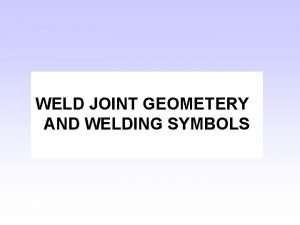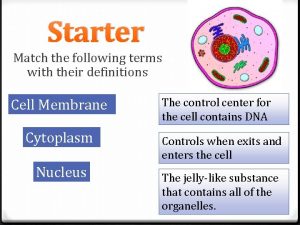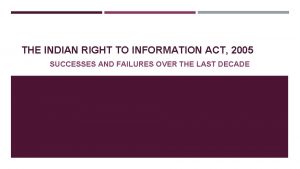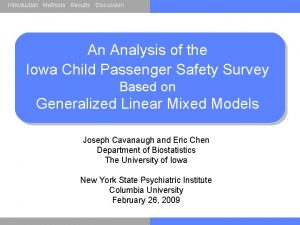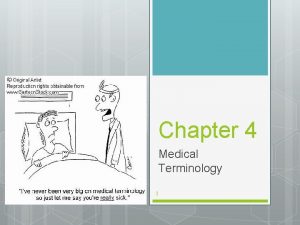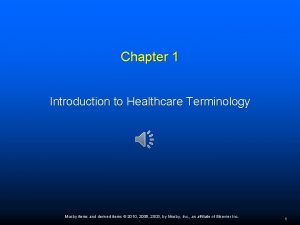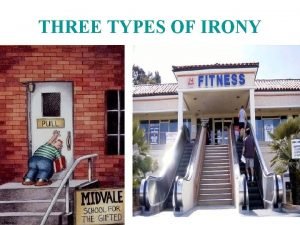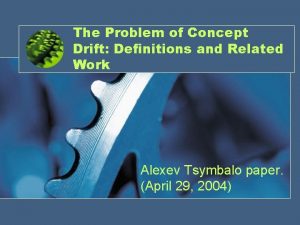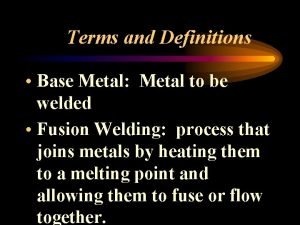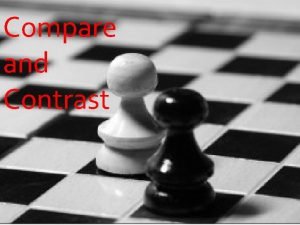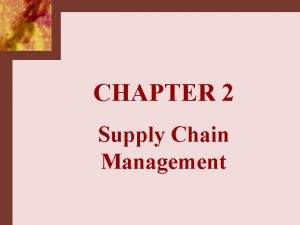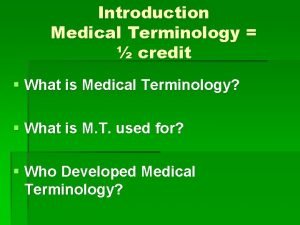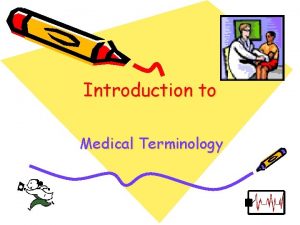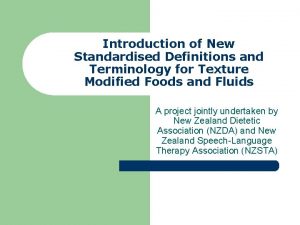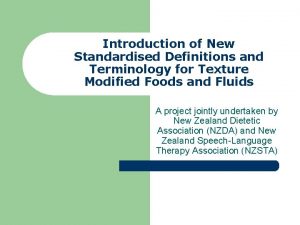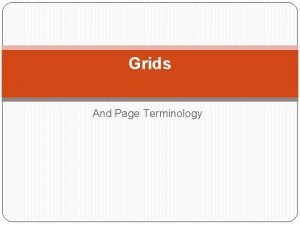Consistent Terminology Consistent Results Introduction and Definitions 2005























- Slides: 23

Consistent Terminology, Consistent Results Introduction and Definitions 2005 MAPLD 5 Design Integrity Concepts

Agenda – Introductions and Definitions • Design integrity – A working definition • Why is this important? – A tale of two designs – Has anything changed? – Why should I care? • The miracle cloud • The alternative – Overview – Implications – Additional Definitions • Summary 2005 MAPLD 6 Design Integrity Concepts

Definition and Goal • Design – The invention and disposition of the forms, parts, or details of something according to a plan. (AH dictionary online) • Integrity – The state of being unimpaired; Soundness; The quality or condition of being whole or undivided; completeness (AH) • This seminar is intended to talk about techniques and issues that ensure the soundness and completeness of both the end product and the means used to produce it. 2005 MAPLD 7 Design Integrity Concepts

Design 1 – Radarsat 1 ACP 2005 MAPLD 8 Design Integrity Concepts

Radarsat 1 ACP Overview • Program dates: late 1990 – late 1992 • Specifications – Processor: 8 MHz 80386/80387 – Memory: 128 k x 8 SRAM, 128 kx 8 EEPROM, 16 k x 8 PROM – Interfaces: A/D (16), D/A (4 -12), Synchronous serial (3 input, 3 output), RS-232 GSE – Function: Attitude control processor for the RADARSAT 1 satellite – Logic Implementation MSI logic + PALs (16 L 8, 16 R 6, 16 R 8) • Additional functions (cross-strap, control) external 2005 MAPLD 9 Design Integrity Concepts

PAL Reminder 2005 MAPLD 10 Design Integrity Concepts

Design 2 - Command Telemetry Board (CTB) 2005 MAPLD 11 Design Integrity Concepts

CTB Overview • Program Dates: early 2001 – late 2003 • Specifications: – Processor: RTX 2010 (16 MHz) – Memory: 4 M x 8 (random), various FIFOs (16 k x 8) as necessary – Interfaces • • • MIL-STD-1553 B Synchronous Serial (command / telemetry) Analog input High-level discrete (output) Low-level discrete (input / output) – Functionality: S/C command/telemetry (level 0 and active) – Logic Implementation: 4 54 SX 32 S FPGAs • Additional resources (in same box): RAD 750, Mass Memory, Instrument Interface Card 2005 MAPLD 12 Design Integrity Concepts

What’s Changed? • Capability / Complexity • Logic Density • Specificity – RADARSAT (1 small specification with interface focus) – CTB (1 large specification with interface, s/w, operations focus) • Software Centricity • Initial Errors – RADARSAT: 3 jumpers; 1 PAL design change – CTB: 14 FPGA revisions • 2 spec change • 5 -6 mistakes • 6 -7 data dependency 2005 MAPLD 13 Design Integrity Concepts

What’s Not Changed? • • Overall program schedules Proportional budget Expectation of correctness Pain from mistakes 2005 MAPLD 14 Design Integrity Concepts

What Explains the Difference? • Engineers aren’t as capable? – Insulting! • Everything is just more complex? – Copout! • Methodology? – Methodology hasn’t changed • Always inadequate, we just got lucky • Adequate for old designs, no longer adequate – Methodology has changed • Used to be adequate, but we lost the recipe • Design philosophy of systems has changed? – Predicated on maximum flexibility – Expectation of extreme complexity – Over-specification – almost impossible to meet 2005 MAPLD 15 Design Integrity Concepts

What Do These Examples Illustrate? • The incidence of initial correctness for designs seems to be decreasing – Design changes seem to be more common – Problems late in the verification/validation cycle seem to be more frequent • Perhaps a combination of the factors presented explains this, but … – Desired complexity is not going to decrease – Budgets are not going to get bigger – The expectation of excellence isn’t going to go away • The only solution is to develop and improve a consistent methodology for implementing robustly designed products – Based on basic principles – Applicable to a variety of conditions 2005 MAPLD 16 Design Integrity Concepts

Why Should I Care? • Why do I work? – Self-actualization (fun, monetary reward, interest) • Why do people want us to work for them? – They need what we produce • What do people want engineers (especially in Aerospace) to produce? – A quality product that satisfies the customer’s needs • How do they want us to produce such a product? – Consistently and efficiently 2005 MAPLD 17 Design Integrity Concepts

The Layman’s View – The Miracle Cloud 2005 MAPLD 18 Design Integrity Concepts

The Miracle Cloud Method • Note that too many engineering schools teach this approach without meaning to • Advantages to the miracle cloud method – Total creative freedom • Disadvantages to the miracle cloud method – Product quality is variable • Team makeup dependent • Team mood/morale dependent (Monday morning car) • Luck dependent – Product is not produced in a repeatable manner – Product is not produced in an efficient manner • Result – Quality low – Customer Satisfaction Low 2005 MAPLD 19 Design Integrity Concepts

How Do We Replace the Miracle Cloud? • • Provide structure to the development effort Evaluate the effort and the product produced Improve the effort and the product Repeat 2005 MAPLD 20 Design Integrity Concepts

Definitions of Importance • From Q 9000 -2000 • Process – A set of interrelated and interacting activities which transforms inputs to outputs [in our case ideas to devices] • Product – The result of a process 2005 MAPLD 21 Design Integrity Concepts

Implications From These Definitions • If we want a consistent product, we must have a consistent process • If we want to improve a product, we must improve the process • If our company has no (or inadequate) process and we must produce a quality product, then we must establish a process [personal responsibility] • Developing, imposing, and improving a process is not an end (in and of itself) it is only a means to an end 2005 MAPLD 22 Design Integrity Concepts

A Model for Discussing the Design Process 2005 MAPLD 23 Design Integrity Concepts

Notes on the Model • Feedback / iteration are not shown for clarity • Model may be recursive – Board development process includes FPGA requirement definition, FPGA development, instantiation, etc. – Board development process includes the FPGA validation product • Successes and failures are cumulative – Good requirements + successful development => successful instantiation – Bad requirements + failed development => failed instantiation • Complexity multiplies – Complex requirements increase design complexity which, in turn, increases verification complexity • Processes are absolute gates to the next stage of development 2005 MAPLD 24 Design Integrity Concepts

Implications From the Model • All processes must be addressed at all levels of design [there are no shortcuts!] – Does not imply same formality at all levels – Does imply same rigor at all levels • Up front work on requirements is essential! – Must provide adequate time and money – Must gain team buy-in to the process* – Benefits compound throughout the rest of the activities • Simplicity is an essential virtue – Complexity inevitably multiplies • A product is not qualified until both verification and validation are complete 2005 MAPLD 25 Design Integrity Concepts

Additional Useful Definitions (courtesy of Q 9000 -2000) • Specification – A document* stating requirements, needs, or expectations that are obligatory • Quality – The degree to which a set of inherent characteristics fulfill requirements • Customer satisfaction – Customer’s perception of the degree to which the customer’s requirements have been fulfilled • Verification – Confirmation, through the provision of objective evidence, that specified requirements have been fulfilled • Validation – Confirmation, through the provision of objective evidence, that the requirements for a specific intended use or application have been fulfilled • Objective evidence – Data supporting the existence or verity of something • Continual Improvement – recurring activity to increase the ability to fulfill requirements • Note the importance of Requirements 2005 MAPLD 26 Design Integrity Concepts

Summary • I have no assurance that my product will have consistent quality without: – Well-defined requirements – A well planned approach to implementing the requirements – A clearly defined plan for verification and validation of the requirements – The ability to improve the process that produces the product • Without quality product, customer satisfaction is impossible • Without customer satisfaction, I won’t work! • Therefore, I must care about ensuring design integrity 2005 MAPLD 27 Design Integrity Concepts
 G in welding
G in welding Match the following terms to their definitions.
Match the following terms to their definitions. Rti act 2005 introduction
Rti act 2005 introduction National curriculum framework 2005
National curriculum framework 2005 Conclusion of ncf 2005
Conclusion of ncf 2005 Introduction, method, result, and discussion
Introduction, method, result, and discussion Chapter 1 learning exercises medical terminology
Chapter 1 learning exercises medical terminology Introduction to medical terminology chapter 1
Introduction to medical terminology chapter 1 Medical shorthand symbols
Medical shorthand symbols Chapter 1 introduction to medical terminology
Chapter 1 introduction to medical terminology Chapter 1 introduction to medical terminology
Chapter 1 introduction to medical terminology Rhinoalgia
Rhinoalgia Introduction to veterinary terminology
Introduction to veterinary terminology Verbal irony in julius caesar
Verbal irony in julius caesar The problem of concept drift: definitions and related work
The problem of concept drift: definitions and related work Safety terms and definitions
Safety terms and definitions A quick primer
A quick primer Material properties and definitions
Material properties and definitions What does incessant mean in hatchet
What does incessant mean in hatchet Weight news value
Weight news value Compare and contrast defintion
Compare and contrast defintion Total cost concept in supply chain management
Total cost concept in supply chain management Which of the following is an undefined term
Which of the following is an undefined term Bansiq
Bansiq
